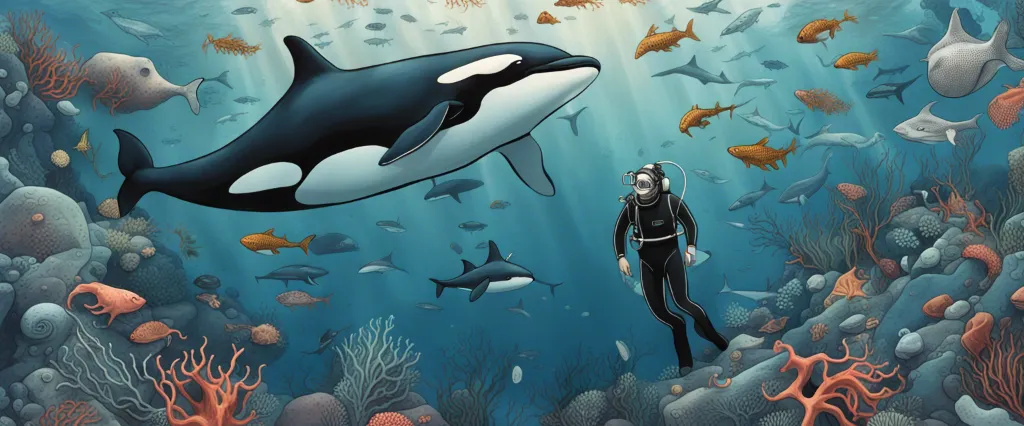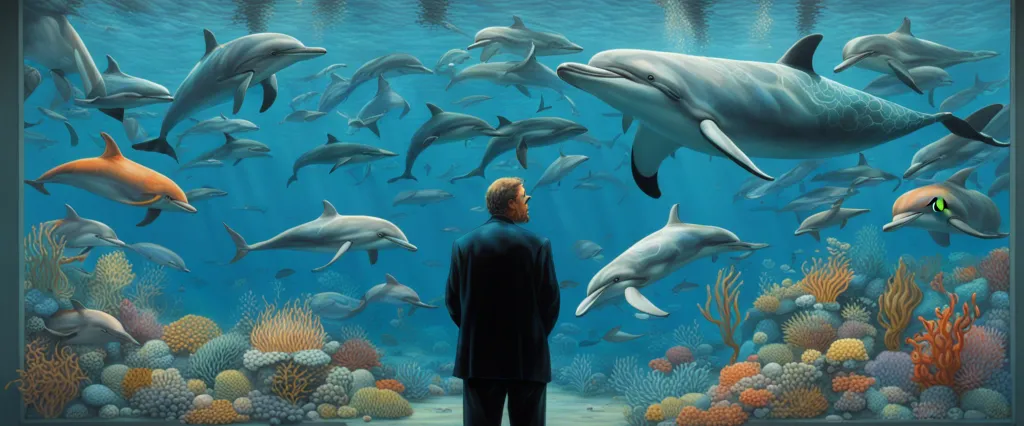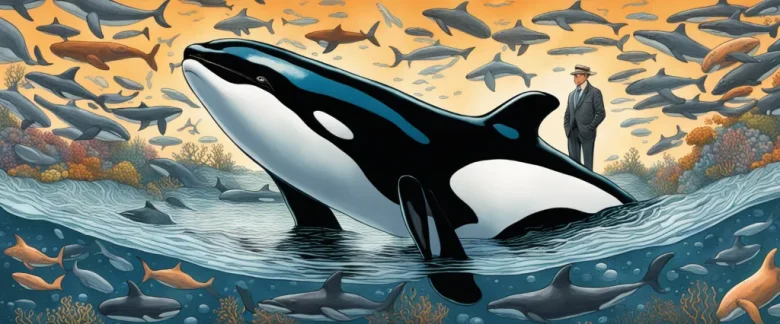In “Beneath the Surface,” John Hargrove provides a gripping and thought-provoking insight into the hidden world of orcas in captivity. As a former senior orca trainer for SeaWorld, Hargrove unveils the dark secrets and heart-wrenching experiences that led to his transformation from an advocate for marine mammal captivity to a passionate activist fighting for their freedom. Drawing from personal experiences and extensive research, Hargrove’s eye-opening account sheds light on the detrimental impact of confinement on these majestic creatures, forcing readers to question the ethical implications surrounding the captivity industry.
Chapter 1: My Journey with Orcas
Chapter 1: My Journey with Orcas of the book “Beneath the Surface” by John Hargrove introduces the author’s lifelong fascination with orcas and his eventual career in the marine entertainment industry. Hargrove recounts his childhood experience at Marine World Africa USA, where he witnessed a captivating orca show that sparked his passion for these magnificent creatures.
As Hargrove grows older, he yearns to work with orcas and joins a SeaWorld park in Texas. He describes the rigorous training program he had to undergo, which involved physical endurance, learning about orca behavior, and developing a strong emotional connection with the animals. Hargrove shares how he developed a deep bond with a particular orca named Katina during his training, further solidifying his commitment to working with these intelligent beings.
Hargrove then transitions to his first encounter with the dark side of marine parks when he witnesses a traumatic incident involving an orca named Kandu. During a live performance, Kandu fatally injures herself after colliding with another orca, shocking both Hargrove and the audience. This tragic event served as a wake-up call for Hargrove, challenging his beliefs about the ethics of keeping orcas in captivity.
The chapter concludes with Hargrove accepting a job at SeaWorld California, where he encounters another orca named Orkid. Despite the captivating orca shows, Hargrove begins to question the welfare of the orcas and the morality of their captivity. This lingering doubt foreshadows the internal struggle Hargrove will face as he progresses further in his career and becomes an advocate for the freedom and well-being of orcas.
In summary, Chapter 1 of “Beneath the Surface” provides an overview of John Hargrove’s initial fascination with orcas, his entry into the marine entertainment industry, and the early experiences that gradually plant the seeds of doubt about the ethics of keeping these majestic creatures in captivity.
Chapter 2: Life in the Wild: Orca Society and Behavior
Chapter 2 of “Beneath the Surface” by John Hargrove, titled “Life in the Wild: Orca Society and Behavior,” delves into the complex social structure and behavior of orcas, commonly known as killer whales, in their natural habitat. Hargrove, an experienced marine mammal trainer, shares his observations and insights based on his years of working closely with these magnificent creatures.
The chapter begins by emphasizing the tight-knit social bonds that exist within orca pods. Each pod consists of a matriarchal hierarchy, with an older female leading the group and making critical decisions. Hargrove highlights the significance of these matrilineal relationships, as orcas exhibit strong maternal instincts, maintain lifelong connections with their offspring, and pass down knowledge from one generation to the next.
Furthermore, Hargrove discusses the importance of orcas’ strong social bonds in their hunting strategies. He reveals that orcas employ various techniques, such as cooperative hunting and group communication, to catch their prey. These tactics showcase the incredible intelligence and cooperation within their pods.
Hargrove also delves into the nuanced vocalizations and distinct dialects of different orca pods. He emphasizes the significance of their vocalizations as a means of communication, bonding, and information-sharing within the pod.
In addition, this chapter sheds light on the emotional lives of orcas. Hargrove describes various instances where he witnessed displays of grief and mourning among orcas, suggesting a depth of emotion that challenges the misconception that these creatures lack complex feelings.
Chapter 2 of “Beneath the Surface” provides an insightful window into the intricate social structure, hunting techniques, vocalizations, and emotional lives of orcas in the wild. Hargrove’s firsthand experiences and observations emphasize the importance of understanding these majestic creatures in order to better protect and preserve their natural habitats.
Chapter 3: Captivity: The Dark Side of the SeaWorld Industry
Chapter 3: Captivity: The Dark Side of the SeaWorld Industry explores the disturbing practices and consequences of keeping orcas in captivity within the SeaWorld theme parks, as described by John Hargrove in his book, Beneath the Surface.
Hargrove begins by sharing his personal experience with orcas and his growing awareness of the detrimental impact of captivity on these magnificent creatures. He describes how orcas in the wild have large, complex social structures and vast living spaces, while those in captivity are confined to small concrete tanks. He details the harmful effects of this confinement, including increased stress levels, sunburn, and dental issues caused by chewing on steel bars.
The chapter delves into the heartbreaking process of capturing wild orcas. Hargrove shares the story of a captured orca named Tokitae, also known as Lolita, who has spent more than four decades in a small tank at Miami Seaquarium. He highlights the inhumane methods used to catch orcas, such as using speedboats to drive them into nets, separating calves from their mothers, and subjecting the captured orcas to long hours of transport in trucks.
Hargrove also exposes the deceptive marketing tactics employed by SeaWorld to portray a happy and healthy environment for the orcas. He reveals that orcas are often given heavy doses of drugs to control aggressive behavior, which contribute to their premature deaths.
Overall, the third chapter of Beneath the Surface raises awareness about the dark side of the SeaWorld industry, shedding light on the numerous ethical concerns and atrocities faced by captive orcas. Hargrove’s account serves as a powerful indictment of the captivity industry and urges readers to question the ethics and legitimacy of keeping these mesmerizing creatures in captivity for human entertainment.
Chapter 4: Training and Exploitation of Orcas

Chapter 4: Training and Exploitation of Orcas in John Hargrove’s book “Beneath the Surface” explores the process of capturing and training orcas for entertainment purposes. Hargrove, a former SeaWorld trainer, sheds light on the dark realities behind the captivating performances presented to the public.
Hargrove begins by recounting an exciting capture mission off the coast of Iceland, where several orcas were corralled into a small cove. The orcas were then separated from their family pods and chosen for captivity based on physical characteristics and behavior. Hargrove describes the agonizing cries and traumatic response exhibited by the captured orcas, emphasizing their profound emotional and psychological distress.
The chapter delves into the intensive training methods employed at SeaWorld to mold the orcas into performing animals. Hargrove exposes the use of food deprivation as a means to gain compliance, forcing the orcas to perform tricks in order to receive sustenance. He highlights the trainers’ reliance on punishment, including withholding food or isolating the orcas, to discourage undesirable behaviors.
Hargrove passionately argues against this exploitative training culture, actively participating in protests and advocating for the release and rehabilitation of captive orcas. He laments the physical degradation he witnessed in his time at SeaWorld, including severe dental issues, collapsed dorsal fins, and numerous health problems attributed to the stress of captivity.
In this chapter, Hargrove’s recounting of the training and exploitation of orcas exposes the inherent cruelty within the captive entertainment industry. He portrays the immense suffering endured by these highly intelligent and sociable creatures, emphasizing the urgent need for change in the treatment of orcas and other marine life in captivity.
Chapter 5: The Consequences of Captivity: Physical and Psychological Effects
Chapter 5 of the book “Beneath the Surface” by John Hargrove delves into the consequences of captivity for marine mammals, particularly killer whales, and explores the physical and psychological effects they endure in captivity. Hargrove, a former killer whale trainer at SeaWorld, provides an eye-opening account of the grave consequences of confining these majestic creatures for entertainment purposes.
Physically, the author exposes the detrimental impact captivity has on killer whales. He reveals how the small tanks these animals are confined to lead to numerous health problems such as collapsed dorsal fins, dental issues, and skin lesions. The inherent need for daily exercise and the lack of space in captivity creates an environment detrimental to killer whales’ physical well-being. Moreover, Hargrove discusses the high occurrence of chronic health issues faced by captive marine mammals, including respiratory diseases, infections, and gastrointestinal disorders.
Beyond the physical effects, the chapter delves into the severe psychological consequences of captivity. Hargrove exposes the intense psychological stress experienced by killer whales, highlighting their highly social and intelligent nature. These creatures are naturally accustomed to living in tight-knit family units and swimming vast distances in the ocean. However, captivity strips them of their natural behaviors and social interactions, leaving them isolated and emotionally unstimulated. The author shares distressing accounts of killer whales exhibiting abnormal behaviors like self-harm, aggression towards trainers, and chronic depression.
In summary, Chapter 5 of “Beneath the Surface” emphasizes the detrimental consequences of captivity on marine mammals, focusing primarily on killer whales. Hargrove exposes the physical ailments caused by confinement, as well as the severe psychological distress endured by these intelligent creatures. The chapter serves as a call to action to reconsider the ethics of keeping marine mammals in captivity for human entertainment, emphasizing the urgent need for change in the industry.
Chapter 6: Speaking Out: Advocacy and Activism
In Chapter 6 of “Beneath the Surface” by John Hargrove titled “Speaking Out: Advocacy and Activism,” Hargrove delves into his journey towards becoming an advocate and activist for killer whale conservation and the welfare of captive marine mammals. He recounts his experiences as a former SeaWorld trainer, shedding light on the ethical concerns and abuse he witnessed firsthand.
Hargrove begins by describing the challenges he faced after leaving SeaWorld. Despite relinquishing his position, he still struggled with the guilt of not speaking out sooner about the mistreatment he saw towards the whales. This guilt becomes a driving force for him to become an advocate and share his experiences with the world.
The chapter also explores Hargrove’s activism against SeaWorld and the quest for legislative changes. He becomes involved with organizations such as PETA and the Animal Welfare Institute, using his firsthand knowledge to support their efforts. Hargrove also addresses the media, raising public awareness about the cruel realities of captivity and the orcas’ suffering.
Through his advocacy, Hargrove encounters resistance not only from SeaWorld but also from individuals within the animal rights movement who question his credibility. Despite these challenges, he perseveres and co-authors a book, “Beneath the Surface,” to redefine his role in the whale conservation movement.
The chapter concludes by emphasizing the crucial connection between public sentiment and legislative action, as well as the need for continued advocacy to bring about meaningful change. Hargrove’s journey from trainer to advocate demonstrates the transformative power of personal experiences in spurring activism, ultimately inspiring him to speak out on behalf of captive marine mammals and work towards lasting change.
Chapter 7: The Future of Orcas in Captivity
Chapter 7 of “Beneath the Surface” by John Hargrove focuses on the future of orcas in captivity. Hargrove, a former SeaWorld trainer, provides a critical evaluation of the industry, its impact on orcas, and the potential for change.
The chapter begins by highlighting the troubling reality that orcas in captivity have generally shorter lifespans than those in the wild. Hargrove emphasizes that the stress and confinement of tanks lead to numerous health issues for these intelligent creatures. He stresses that the current practices of captive breeding and subsequent separation of families further exacerbate the distress experienced by orcas.
Hargrove then examines the argument made by some in the industry that orcas in captivity serve valuable educational purposes. He disputes this claim, pointing out that many of the educational aspects could be achieved through more humane means, such as observing orcas in the wild or through virtual reality experiences.
The author explores the backlash faced by SeaWorld following the release of the documentary “Blackfish,” which exposed the cruelty of captive orca environments. The public opinion shifted, prompting increased scrutiny of the industry’s practices. Hargrove also notes the impact of legislation, such as the California Coastal Commission’s decision to ban breeding of captive orcas, which has contributed to SeaWorld’s decision to phase out their orca shows.
Moving forward, Hargrove discusses the emergence of sanctuaries as a potential solution for retired captive orcas. He expresses hope that these sanctuaries can provide a more natural environment where orcas can live out the remainder of their lives with greater freedom and dignity.
Ultimately, Hargrove argues that the future of orcas in captivity is uncertain, as the industry faces increasing pressure from activists and evolving public opinion. He advocates for a world where these magnificent creatures are no longer held captive for entertainment, but rather, respected and observed in their natural habitats.

Chapter 8: A Call for Change: Towards a Better Future for Orcas
Chapter 8 of “Beneath the Surface” by John Hargrove, titled “A Call for Change: Towards a Better Future for Orcas,” examines the urgent need for improved conditions and treatment of captive killer whales. Hargrove, a former SeaWorld trainer, shares his personal experiences and observations to shed light on the realities faced by these highly intelligent and social creatures.
The chapter begins by highlighting the negative repercussions of keeping orcas in captivity. Hargrove discusses the physical and mental ailments that plague captive orcas, such as collapsed dorsal fins, dental issues, and the psychological distress arising from being confined to small tanks. He emphasizes the stark contrast between the natural habitat of these majestic beings and the confines of their captive environments.
Hargrove further delves into the unethical practices employed by marine theme parks like SeaWorld. He reveals behind-the-scenes information regarding the separation of orca mothers and calves, the effects of forced breeding programs, and the cover-ups of incidents resulting in injury or death of trainers. By exposing these practices, he aims to raise awareness and evoke a call for change in the treatment of orcas.
Towards the end of the chapter, Hargrove explores the groundbreaking documentary “Blackfish” and its significant impact on public perception and the captive orca industry. He discusses how the film prompted a wave of public backlash against SeaWorld and ultimately led to a decline in attendance and revenue for the marine park.
In summary, Chapter 8 of “Beneath the Surface” provides a compelling argument for a better future for orcas. Hargrove calls for an end to captivity and urges readers to join the fight against the mistreatment and exploitation of these magnificent creatures.
After Reading
In the book “Beneath the Surface” by John Hargrove, the author provides an eye-opening and gripping account of his experience working as a senior trainer at SeaWorld. Hargrove takes readers on a journey through his personal transformation from a devoted advocate for the park to a vocal critic of its practices and treatment of captive whales. Through vivid descriptions and personal anecdotes, he exposes the dark side of the marine park industry and raises important questions about the ethical considerations surrounding keeping these majestic creatures in captivity. Ultimately, Hargrove’s heartfelt and thought-provoking narrative demonstrates the urgent need for change and compassion towards these intelligent and emotionally complex beings.
1. Crazy Like Us: The Globalization of the American Psyche” by Ethan Watters:
In this eye-opening book, Ethan Watters explores the impact of American cultural beliefs on the treatment of mental illness around the world. Through compelling stories and extensive research, Watters challenges the assumption that Western mental health practices are universally beneficial. A must-read for anyone interested in cultural psychology and the globalization of psychiatric care.
2. “Behind the Beautiful Forevers: Life, Death, and Hope in a Mumbai Undercity” by Katherine Boo:
Katherine Boo’s non-fiction masterpiece brings to life the harsh realities of the Annawadi slum in Mumbai. By following the lives of individuals striving for better opportunities, Boo beautifully captures the hope, despair, and resilience of the human spirit. This insightful and deeply affecting book shines a light on the issues of poverty, inequality, and urbanization in modern-day India.
3. The Immortal Life of Henrietta Lacks” by Rebecca Skloot:
Skloot delves into the gripping true story of Henrietta Lacks, an African American woman who unknowingly provided the cells that revolutionized medical research. This captivating narrative explores the ethical implications surrounding Lacks’ cells, as well as the personal story of her family’s journey to understand her legacy. Skloot’s meticulous research and compassionate storytelling make this book an engrossing exploration of race, science, and human rights.
4. Sapiens: A Brief History of Humankind” by Yuval Noah Harari:
In this thought-provoking book, Yuval Noah Harari takes readers on a captivating journey through the history of Homo sapiens. From the emergence of our species to the present day, Harari examines the key events and developments that shaped our species into dominant global players. With a unique blend of anthropology, history, and philosophy, “Sapiens” offers fresh perspectives on our collective past and raises important questions about our future.
5. Quiet: The Power of Introverts in a World That Can’t Stop Talking” by Susan Cain:
Susan Cain’s groundbreaking book challenges the notion that extroversion is the ideal personality trait in modern society. Drawing on scientific research and engaging anecdotes, Cain celebrates the power and unique strengths of introverts, while exploring the pressures they face in today’s extrovert-dominated culture. For introverts and extroverts alike, “Quiet” provides valuable insights and strategies for embracing and empowering introverted individuals.



